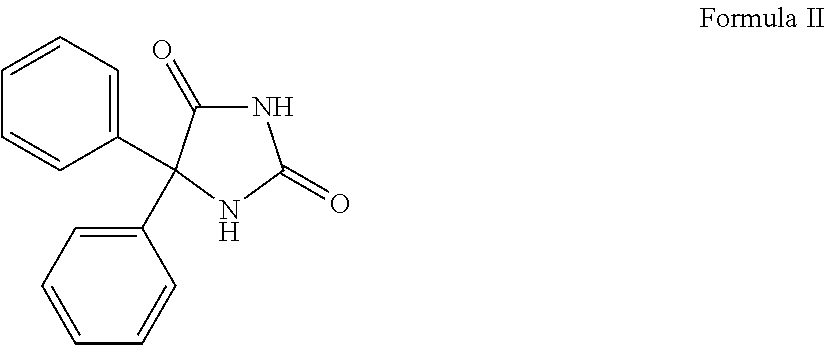Wound healing compositions based on cyanoacrylates and 5,5-disubstitutedhydantoins, including phenytoin
a technology of cyanoacrylates and phenytoins, which is applied in the field of stable, sterilizable liquid adhesive compositions, can solve the problems of difficult regulation of active compound dosage, limited application, and difficult wound management, and achieve enhanced wound sealing and physical film barrier properties, enhanced wound healing effects, and superior wound management techniques
- Summary
- Abstract
- Description
- Claims
- Application Information
AI Technical Summary
Benefits of technology
Problems solved by technology
Method used
Image
Examples
example 1
[0083]To a three neck round bottom flask equipped with a thermometer and a magnetic stir bar, 118.7 g of 2-octyl cyanoacrylate monomer containing 270 ppm of 18-crown-6 was stabilized with BHA and SO2, which was mixed with 0.12 g of phenyloin and stirred at 80° C. for about 2 hours. After it cooled down, no precipitate was observed and the resulting cyanoacrylate composition was a clear and homogeneous solution.
example 2
[0084]A mixture of cyanoacrylate monomer including 80% 2-octyl cyanoacrylate and 20% n-butyl cyanoacrylate was stabilized with BHA and SO2.251.1 g of such mixture of cyanoacrylate was mixed with 0.25 g of phenyloin in a three neck round bottom flask. The resulting heterogeneous mixture was heated to 78° C. and stirred for about an hour until all phenyloin was dissolved in the cyanoacrylate monomers. After cooling down to room temperature, the homogenous solution was stirred overnight at room temperature to check the miscibility of phenyloin with cyanoacrylate monomers. 10 ppm of SO2 was added to the solution to stabilize the cyanoacrylate composition containing phenyloin.
example 3
[0085]To a three neck round bottom flask equipped with a thermometer and a magnetic stir bar, 115.6 g of n-butyl cyanoacrylate monomer stabilized with BHA and SO2 was mixed with 0.35 g of phenyloin and stirred at 80° C. until all visible solid particles of phenyloin were dissolved in n-butyl cyanoacrylate. After it cooled down, no precipitate was observed and the resulting cyanoacrylate composition was a clear and homogeneous solution. The viscosity and set time of the resulting composition was 5.36 cps and 14 seconds, respectively.
PUM
| Property | Measurement | Unit |
|---|---|---|
| temperature | aaaaa | aaaaa |
| temperature | aaaaa | aaaaa |
| temperature | aaaaa | aaaaa |
Abstract
Description
Claims
Application Information
 Login to View More
Login to View More - R&D
- Intellectual Property
- Life Sciences
- Materials
- Tech Scout
- Unparalleled Data Quality
- Higher Quality Content
- 60% Fewer Hallucinations
Browse by: Latest US Patents, China's latest patents, Technical Efficacy Thesaurus, Application Domain, Technology Topic, Popular Technical Reports.
© 2025 PatSnap. All rights reserved.Legal|Privacy policy|Modern Slavery Act Transparency Statement|Sitemap|About US| Contact US: help@patsnap.com



